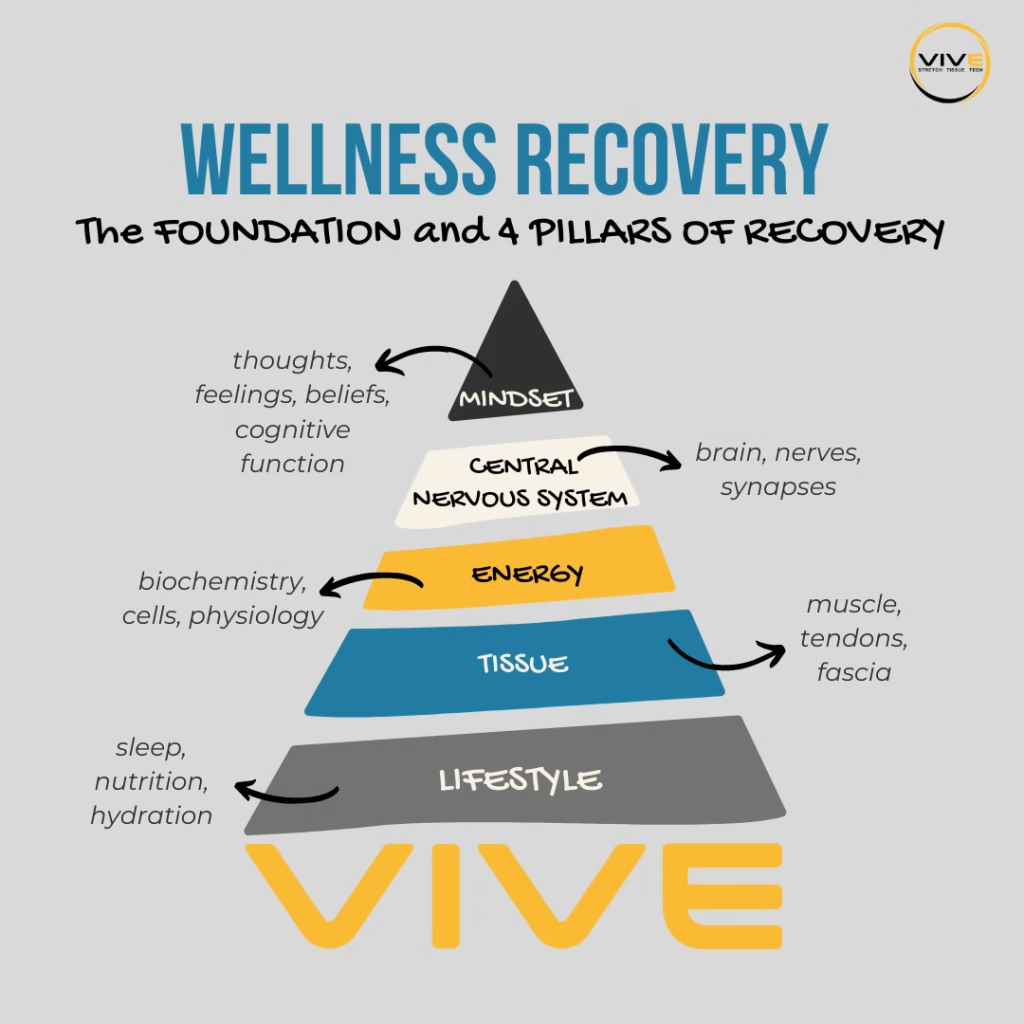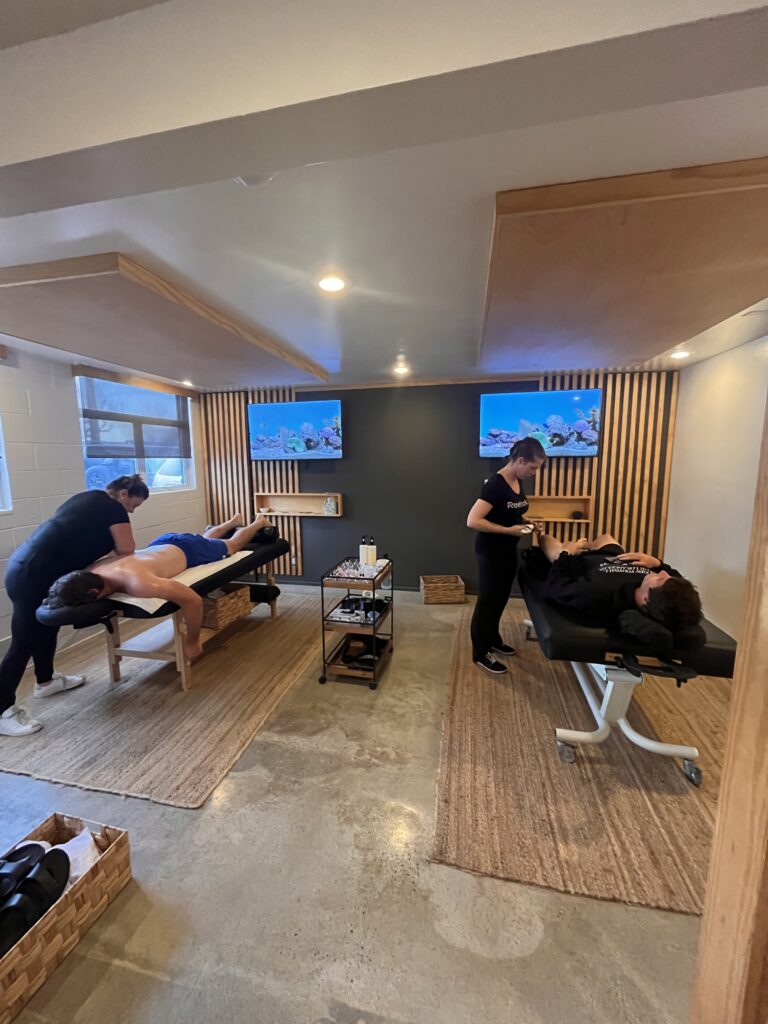Recovery isn’t just something tennis players do after a match—it’s a fundamental skill. One that separates athletes who thrive from those who break down.
If you’re a tennis player—or a parent of a junior athlete—you already know how physically demanding the sport is. Long matches. Multiple training sessions a day. Travel. Heat. Mental fatigue. And the year-round nature of the tennis calendar means there’s rarely time to stop and rest.
That’s why recovery for tennis players needs to be approached with the same thoughtfulness and structure as training.
In this guide, we’ll walk through a recovery pyramid—a hierarchy of what matters most—so tennis players can recover faster, reduce injury risk, and perform at their best throughout the season.
1. Master the Foundation: Sleep, Hydration, and Nutrition
The biggest mistake we see tennis players make? Skipping over the basics.
Before using any recovery tools or supplements, players need to dial in the fundamentals. These three lifestyle factors form the foundation of recovery.

Sleep: The Ultimate Recovery Tool
Sleep isn’t passive—it’s when the body repairs tissue, restores the nervous system, and consolidates skills learned during practice. Most junior athletes need 8–10 hours per night. Professional players often nap during the day to help meet their recovery needs.
Chronic sleep deprivation leads to slower reaction time, poor decision-making, increased injury risk, and plateaus in performance.
Hydration: The Silent Performance Killer
Even mild dehydration can affect coordination, energy, and focus. Tennis players lose significant fluid through sweat, especially in long matches or hot climates.
Tips:
- Hydrate throughout the day, not just around practices or matches
- Use electrolyte drinks if training for more than 60 minutes
- Monitor urine color—it should be light yellow
Nutrition: Fuel Before, Refuel After
Tennis players need consistent fueling throughout the day—not just big meals at night. Under-fueling leads to fatigue, slower recovery, and hormonal issues in youth athletes.
Key habits:
- Eat a balanced meal or snack before training
- Refuel with protein + carbs after sessions
- Don’t skip meals—especially during tournament weeks
When these three pillars are inconsistent, recovery stalls—no matter how many ice baths or supplements you throw at the problem.
2. Structure Recovery Into the Training Plan
Recovery isn’t just what happens after training. It should be built into the training plan itself.
Tennis is a sport with high physical and neurological demands. If every day is intense, the body never fully recovers or adapts. Over time, this leads to fatigue, burnout, or injury.
A smart weekly schedule includes:
- Hard training days balanced with easier ones
- At least one full rest day per week (especially for youth athletes)
- Variation in intensity, volume, and movement demands
Players working with experienced coaches and strength professionals tend to stay healthier and improve faster. If recovery isn’t part of the training plan, it’s already failing the athlete.
3. Build the Engine: Conditioning Supports Recovery
Here’s an often-overlooked truth:
The better conditioned an athlete is, the faster they recover.
Yes, tennis is an intermittent sport—short bursts of effort followed by rest. But the aerobic system underpins everything. A strong aerobic base improves heart rate recovery, supports mitochondrial function, and helps clear fatigue-related byproducts during and after matches.
Benefits of a strong aerobic system:
- Faster recovery between games and sets
- Better energy regulation during long matches
- Improved endurance across tournaments and training weeks
- Less soreness and quicker bounce-back between sessions
Cross-training options like steady-state cardio (bike, swim, row, jog) and tempo runs can all support aerobic development—especially in younger athletes still building their engine.
4. Maintain Tissue Quality and Mobility
Recovery isn’t just about energy. It’s also about movement.
As tennis players train and compete, their tissues take on mechanical stress—repetitive loads that lead to tightness, imbalance, and eventually dysfunction. Without regular attention, players lose range of motion, develop compensations, and increase injury risk.

How to maintain tissue pliability:
- Self-Myofascial Release (SMR): Foam rolling, lacrosse balls, or massage guns can reduce muscle tension and improve blood flow
- Stretching: Use dynamic stretches before play and static stretches after to maintain flexibility
- Professional Tissue Work: Regular sessions with recovery specialists help restore balance, identify problem areas, and maintain peak mobility. We aren’t just talking about getting a massage, but focused manual tissue work.
Common problem areas in tennis include the shoulders, forearms, hips, and spine. Keeping these areas mobile and pliable supports better mechanics, reduces overuse, and enhances longevity.
5. Use Recovery Tools—But Only After the Basics Are Covered
Too many players try to fix poor habits with fancy tools. But no modality can make up for bad sleep, poor nutrition, or inadequate tissue care.
That said, once the core elements are in place, recovery tools and supplements can offer real benefits—especially during periods of heavy training or tournament play.
Smart recovery tools for tennis players:
- Red Light Therapy: May support mitochondrial health, reduce inflammation, and accelerate tissue repair
- Cold Therapy (Ice Baths): Can help reduce soreness and inflammation, especially during intense weeks
- Sauna: Supports circulation, aids relaxation, and may boost aerobic adaptations
- Supplements: Creatine, protein powders, electrolytes, and omega-3s can all support recovery—when used appropriately and alongside proper diet
Key takeaway: These tools work best on top of a solid foundation—not instead of it.
Conclusion: Recovery Is a Habit, Not a Hack
Tennis is a demanding sport. It rewards players who take care of their bodies—not just in the short term, but across years and decades of development.
If you’re a junior player (or a parent guiding one), remember: you don’t have to do everything. But you do need to do the right things, consistently.
Start with the basics. Build good habits early. Use training plans that include rest. Stay conditioned. Maintain your tissue health. Then, and only then, layer in advanced recovery tools.
Because the goal isn’t just to survive the season. It’s to stay healthy, compete fully, and love the game for the long haul.
Looking for Personalized Recovery for Tennis Players?
At Vive Recovery Studio, we help athletes—from junior tennis players to pros—build recovery routines that match their training demands. Whether it’s tissue work, cold therapy, red light, or education around recovery planning, we’re here to help you play harder, recover faster, and stay in the game longer.
